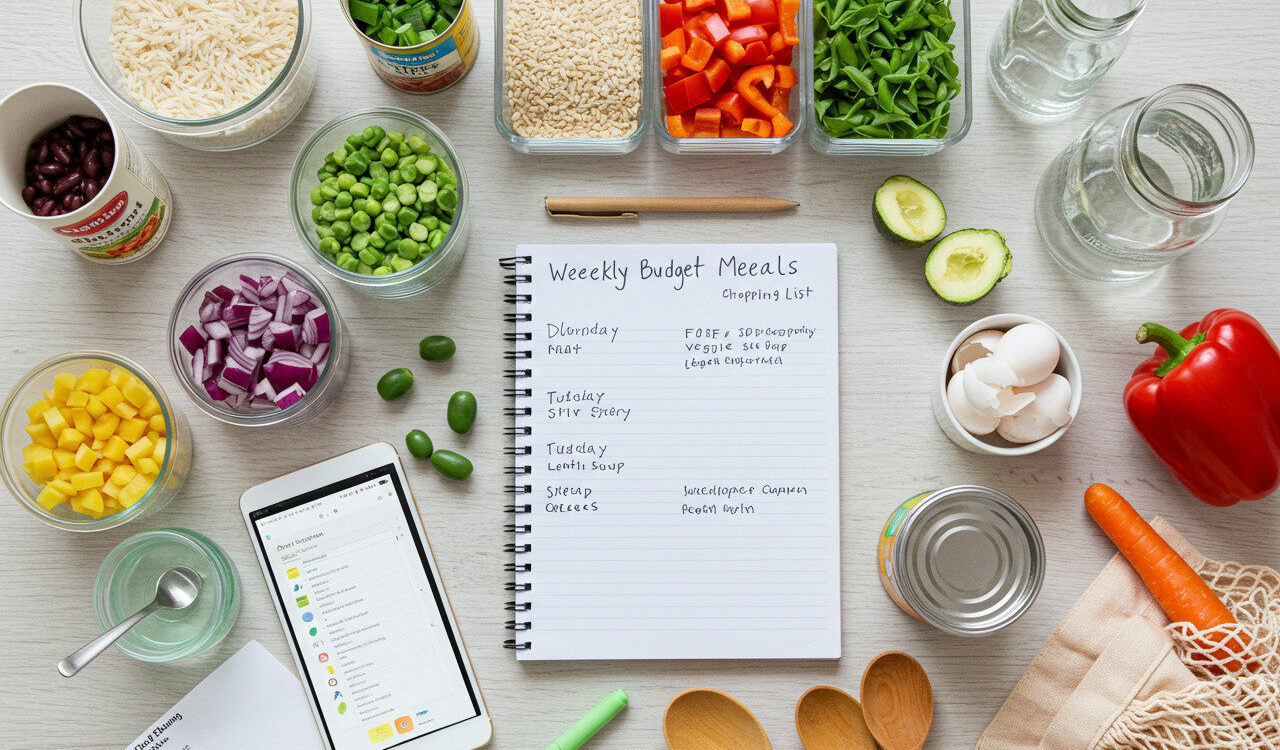Highlights
- Learn fast and smart ways to plan meals on a budget, perfect for beginners.
- See how pantry staples can help you turn simple foods into cost-saving meals.
- Discover the benefits of batch cooking and meal prep for time and money savings.
- Get practical tips to reduce food waste with better grocery planning and leftover use.
- Explore affordable dinner recipes, snack ideas, and plant-based meals for daily living.
- Make your grocery budget go further with tips like buying seasonal and sale items.
Introduction
Feeding yourself or your family on a tight grocery budget doesn’t mean sacrificing flavor or nutrition. With some creativity and a little planning, you can turn simple ingredients into satisfying, affordable meals. In this beginner-friendly guide, you’ll find 10 easy budget meal planning tips that will help lower your food costs while keeping meals delicious and stress-free.
Budget Meal Planning Ideas
1. Create a Weekly Meal Plan Using Low-Cost Staples
Start your weekly meal plan by building it around affordable pantry staples like rice, beans, pasta, eggs, and frozen vegetables. These items offer versatility and keep meal costs low.
Check your pantry and fridge before making your grocery list. Combine staples with fresh ingredients such as canned tomatoes, tuna, or seasonal vegetables. For example, canned tuna can be used in casseroles, salads, or sandwiches, giving you multiple options from one item.
Having a detailed list also prevents impulse buys and food waste. Planning meals ahead reduces stress and opens the door to trying out simple, budget-friendly recipes throughout the week.
2. Batch Cook and Freeze Meals for Busy Days
Batch cooking saves both time and money. Dedicate a few hours each week to cooking large portions of meals like soups, casseroles, or chili. Freeze the extras in portioned containers for quick, reheatable meals on hectic days. This strategy reduces takeout spending and helps you stick to your meal plan.
3. Make Use of Leftovers to Minimize Food Waste
Turn leftovers into new meals instead of tossing them. For instance, roasted chicken can be repurposed into chicken salad or sandwiches. Cooked vegetables can be blended into soups or added to stir-fries. By reimagining leftovers, you stretch your grocery dollars and reduce waste.
4. Shop with a Grocery List to Avoid Impulse Buys
A well-organized grocery list keeps spending in check and reduces food waste. Before shopping, inventory your pantry, fridge, and freezer. Plan meals around what you already have and buy only what you need. This approach not only saves money but also helps you avoid buying duplicates or unnecessary items.
5. Focus on One-Pot or Sheet Pan Recipes
One-pot and sheet pan meals are ideal for budget-conscious cooks. They simplify cleanup and reduce the number of ingredients you need. Common ingredients like potatoes, broccoli, and chicken can be cooked together on a sheet pan for a healthy, budget-friendly dinner.
6. Add Plant-Based Proteins Like Beans and Lentils
Plant-based proteins such as lentils, black beans, and tofu are nutritious, affordable, and filling. They can be used in tacos, soups, salads, or stir-fries. Buying them in bulk, especially dried, saves money and pantry space. Season with spices like cumin or paprika to enhance flavor.
| Plant Protein | Best Meal Uses |
|---|---|
| Black Beans | Chili, Tacos, Enchiladas |
| Lentils | Soups, Meatloaf, Salads |
| Tofu | Stir-fries, Eggless Scrambles, Protein Bowls |
7. Use Seasonal and Sale Produce to Save the Most
Fruits and vegetables that are in season often taste better and cost less. Plan your meals based on what’s in season or currently on sale at local stores. Consider buying in bulk and freezing extras for later use. Stores like Aldi are great for finding affordable produce options.
8. Prepare Simple Breakfasts Ahead of Time
Start your day with a low-cost breakfast by prepping ahead. Items like oats, yogurt, eggs, and pancakes are easy to make and customize. Batch-prep overnight oats or breakfast burritos so you always have a ready-to-go option.
9. Try DIY Snack and Lunch Ideas for Work or School
Homemade snacks and lunches reduce costs and help you eat healthier. Try simple options like granola bars, trail mix, hummus with veggies, or peanut butter wraps. Packing your own meals means fewer expensive trips to the vending machine or lunch counter.
10. Stock Up on Multi-Use Pantry Needs
Pantry items like canned tomatoes, dry pasta, oats, peanut butter, and frozen vegetables are inexpensive and long-lasting. These staples serve as the base for many budget-friendly meals and reduce the need for frequent grocery trips.
Final Thoughts
Budget meal planning is a practical way to save money, reduce waste, and simplify your cooking routine. By using these 10 beginner-friendly ideas, you can make healthy, flavorful meals without overspending. Focus on planning ahead, making the most of pantry staples, and using leftovers creatively. With just a little effort each week, you’ll find it easier to eat well and stay on budget.
Frequently Asked Questions
What are the best foods to buy for meal planning on a budget?
Look for versatile, long-lasting items like rice, beans, pasta, eggs, oats, frozen vegetables, canned tomatoes, and tuna. These foods can be used in many recipes and help stretch your grocery budget.
How can I eat healthy meals while staying within a budget?
Plan meals ahead of time, focus on seasonal produce, and buy in bulk when possible. Use affordable proteins like lentils and chicken, and include a mix of whole grains, vegetables, and healthy fats.
How much time should I spend on budget meal planning each week?
Most people spend 1–2 hours weekly on meal planning. This includes reviewing what’s already in the kitchen, selecting recipes, making a shopping list, and prepping ingredients. With practice, it becomes quicker and easier.
Updated by Albert Fang
Source Citation References:
+ Inspo
There are no additional citations or references to note for this article at this time.
